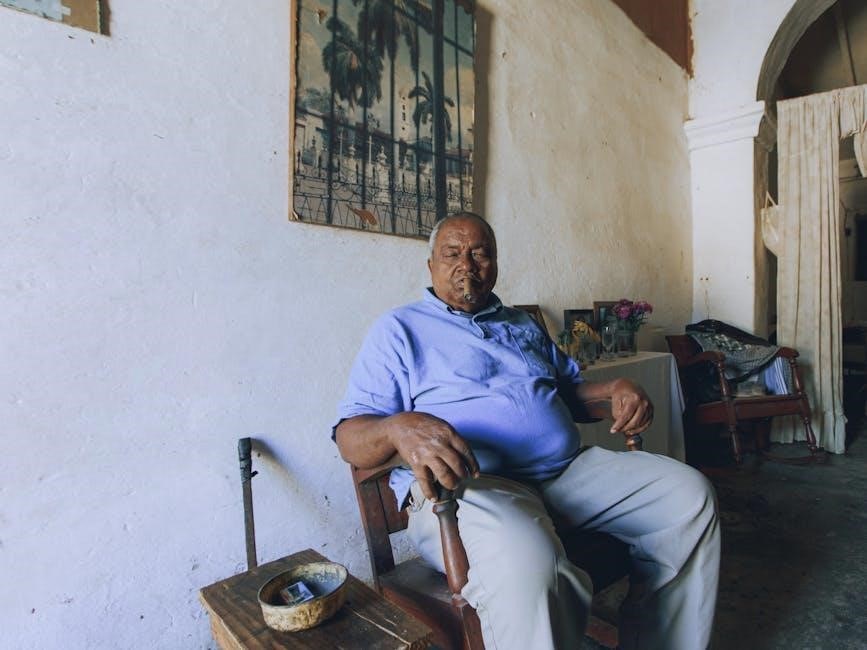The Gentleman’s Guide to Vice and Virtue explores themes of morality, identity, and societal expectations in 18th-century Europe, blending history with vibrant storytelling.
Defining Vice and Virtue in Historical Context
In 18th-century Europe, vice often symbolized indulgence in pleasure, rebellion, or immorality, while virtue represented adherence to societal norms and moral integrity. The Grand Tour, a rite of passage for elites, exposed individuals to contrasting cultures, amplifying internal and external moral conflicts. This dichotomy shaped identities and societal expectations, as individuals grappled with personal desires versus public decorum.
The Evolution of Moral Concepts
Moral concepts in 18th-century Europe evolved through societal shifts and personal experiences. The Grand Tour exposed travelers to diverse cultures, challenging rigid moral frameworks. As individuals encountered new ideas, their understanding of vice and virtue transformed, blending traditional values with newfound perspectives. This evolution reflected broader cultural changes, where personal identity and societal expectations began to intersect more fluidly.
Historical Context of the Grand Tour
The Grand Tour, a quintessential 18th-century journey, exposed elite youths to Europe’s cultural and artistic splendor, shaping their identities amidst societal expectations and moral dilemmas.
The Grand Tour’s Role in 18th-Century Europe
The Grand Tour served as a rite of passage for young elites, blending education, cultural immersion, and self-discovery; It shaped identities, fostered connections across Europe, and influenced societal expectations, while also offering opportunities for indulgence and moral exploration, as depicted in The Gentleman’s Guide to Vice and Virtue.
Societal Expectations and Moral Dilemmas
Society demanded conformity to strict moral codes, yet the Grand Tour offered a space for exploration and deviation. Characters like Monty faced dilemmas between indulging desires and meeting expectations, highlighting the tension between personal freedom and societal norms in 18th-century Europe, as vividly portrayed in The Gentleman’s Guide to Vice and Virtue.

The Book’s Plot and Structure
The Gentleman’s Guide to Vice and Virtue follows Monty on his Grand Tour, blending witty dialogue, emotional depth, and historical richness in a compelling narrative journey.
Overview of “The Gentleman’s Guide to Vice and Virtue”
The Gentleman’s Guide to Vice and Virtue is a captivating novel set in 18th-century Europe, following Monty Montague on his Grand Tour. With wit, humor, and emotional depth, the story explores themes of identity, morality, and relationships. Blending historical detail with a modern voice, it offers a fresh perspective on vice and virtue, making it a compelling and unforgettable read.
Narrative Techniques and Storytelling Style
Mackenzi Lee employs a vibrant, witty narrative voice, blending humor with emotional depth. The story unfolds through Monty’s perspective, offering a personal and engaging exploration of his journey. Historical details are woven seamlessly into the plot, creating an immersive experience. The author’s use of dialogue and character interactions adds authenticity, while the modern tone makes the 18th-century setting relatable and fresh for contemporary readers.

Themes in The Gentleman’s Guide
The novel explores themes of identity, love, and societal expectations, blending historical context with contemporary relevance. It delves into self-discovery, relationships, and societal pressures, offering a fresh perspective on 18th-century Europe through vivid storytelling.
Identity and Self-Discovery
The novel delves into themes of identity and self-discovery, particularly through Monty and Percy’s journeys. Monty’s struggle with his bisexuality and Percy’s quiet introspection highlight the challenges of navigating societal expectations in 18th-century Europe. The story weaves these personal quests into the broader narrative of adventure and romance, offering a relatable exploration of self-acceptance and growth.
Love and Relationships in the 18th Century
The novel intricately portrays love and relationships amidst the societal norms of 18th-century Europe. Monty and Percy’s bond challenges traditional expectations, exploring themes of forbidden love and self-acceptance. The story highlights the tension between societal pressures and personal desires, offering a nuanced portrayal of romance in a rigid historical context. Their relationship becomes a cornerstone of the narrative, blending passion and vulnerability seamlessly.
Societal Pressure and Expectations
The novel vividly portrays the stifling societal pressures of 18th-century Europe, where conformity to expectations governed behavior. Monty’s reckless antics and inner turmoil reflect his struggle to meet societal norms while embracing his true self. The story highlights how these pressures shaped identities and relationships, forcing characters to navigate a world where reputation and duty often clashed with personal desire and authenticity.

Character Analysis: Montague Siblings
The Montague siblings—Monty, Percy, and Felicity—embark on journeys of self-discovery, grappling with vice, virtue, and societal norms. Their complex relationships and personal struggles drive the narrative.
Monty’s Journey: Vice and Redemption
Monty’s journey in The Gentleman’s Guide to Vice and Virtue is a compelling exploration of self-discovery and redemption. Beginning as a reckless, pleasure-seeking young noble, Monty’s Grand Tour of Europe forces him to confront his flaws and desires. His bisexuality and internal conflicts are central to his growth, as he learns to balance vice with virtue, embracing his true self amidst societal expectations.
Percy’s Struggles and Growth
Percy’s journey in The Gentleman’s Guide to Vice and Virtue is marked by quiet strength and introspection. As Monty’s brother, he grapples with societal expectations and internal conflicts, particularly regarding his bisexuality. Percy’s growth is subtle yet profound, as he learns to navigate love, loyalty, and identity, becoming a stabilizing force in Monty’s chaotic life while finding his own path to self-acceptance and happiness.
Felicity’s Role and Influence
Felicity Montague is a brilliant, fiercely independent young woman who challenges 18th-century gender norms. Her sharp wit, determination, and medical aspirations inspire those around her. As Monty and Percy’s younger sister, she offers a unique perspective, pushing boundaries and influencing her brothers’ journeys. Her presence sparks growth and reflection, making her a pivotal figure in their lives and the story’s progression.
Representation in the Novel
The novel excels in portraying underrepresented voices, offering a fresh perspective on diverse identities in 18th-century Europe. Its inclusive storytelling has garnered critical acclaim and recognition.
Bisexuality and LGBTQ+ Themes
The Gentleman’s Guide to Vice and Virtue stands out for its authentic portrayal of LGBTQ+ characters, particularly Monty’s bisexuality, a rare representation in YA literature. The novel explores themes of identity, love, and societal acceptance, resonating deeply with readers. Its nuanced storytelling has earned it a Stonewall Honor and widespread acclaim for its inclusive and impactful narrative.
Gender Roles and Expectations
The Gentleman’s Guide to Vice and Virtue challenges traditional gender roles through its characters, particularly Felicity, who defies societal norms by pursuing intellectual and medical ambitions. The novel highlights the constraints placed on both men and women, emphasizing the tension between conformity and individuality in 18th-century Europe. This portrayal resonates with modern readers, offering a fresh perspective on gender identity and societal expectations.

The Role of Morality in the Story
Morality is central to the narrative, as characters like Monty and Percy grapple with vice and virtue, their choices shaping redemption and personal growth in a complex world.
Moral Dilemmas and Choices
Moral dilemmas are central to the novel, as characters like Monty and Percy navigate internal conflicts and societal expectations. Their choices, often torn between vice and virtue, drive personal growth and shape relationships. The story highlights the tension between indulgence and responsibility, showcasing how morality influences decisions and ultimately defines character development in a world of shifting values and pressures.
The Impact of Virtue on Character Development
Virtue plays a pivotal role in shaping the Montague siblings’ growth, as they confront their flaws and strive for self-improvement. Through their journeys, virtue fosters empathy, responsibility, and authenticity, countering the allure of vice. This transformation highlights the enduring power of moral integrity, influencing relationships and personal fulfillment in a world where societal expectations often clash with individual values and aspirations.
Historical Accuracy vs. Creative Freedom
The novel skillfully blends historical authenticity with imaginative storytelling, capturing the essence of 18th-century Europe while exploring themes that resonate with modern readers, balancing fact and fiction seamlessly.
Blending Fact and Fiction
The novel weaves historical facts about 18th-century Europe with fictional narratives, creating a compelling story. Monty’s Grand Tour reflects real European cultural influences while the characters’ personal journeys remain imaginative. This blend enriches the plot, offering readers both educational insights and engaging storytelling. The balance between historical accuracy and creative freedom enhances the novel’s appeal and depth, making it both informative and entertaining.
Artistic Liberties in Portrayal
The novel takes creative liberties to enhance character development and narrative depth. While rooted in historical context, the portrayal of Monty’s vice-ridden adventures and Percy’s silent struggles veers from traditional depictions, adding emotional richness. Cultural settings like European cities are vividly reimagined, blending real history with imaginative storytelling to captivate readers and explore timeless themes through a modern lens, making the story relatable and engaging.
The Significance of Setting
Europe serves as a vibrant backdrop, with cities like Paris, Rome, and Venice shaping the narrative. The setting reflects cultural richness and the characters’ emotional journeys, blending history with personal growth and exploration, while also highlighting the contrast between societal beauty and internal struggles.
Europe as a Character in the Novel
Europe emerges as a dynamic character, shaping identities and experiences. From Paris’s allure to Rome’s history, each city embodies distinct cultural and emotional landscapes. The continent’s diversity mirrors the characters’ internal struggles, offering both inspiration and conflict. This personification of Europe enriches the narrative, making it a central, evolving force in the story.
Cultural Influences on the Narrative
The novel is deeply influenced by 18th-century European culture, weaving in societal norms, artistic movements, and historical events. From the opulence of Paris to the grandeur of Rome, each location’s unique cultural identity shapes the characters’ experiences. The narrative reflects the era’s music, art, and literature, creating a rich tapestry that immerses readers in the continent’s diverse heritage and its impact on the story’s progression.
Literary Style and Tone
The novel’s literary style blends wit, humor, and adventure, creating a dynamic tone that balances emotional depth with historical context, appealing to a broad audience.
Wit and Humor in the Narrative
The novel’s witty dialogue and humorous moments provide a lively contrast to its historical backdrop, creating a charming and engaging narrative. Monty’s sharp tongue and comedic misadventures add light-heartedness, while the story’s adventurous tone ensures an entertaining journey. The interplay of humor with deeper themes like identity and morality makes the book both enjoyable and thought-provoking, appealing to a wide range of readers.
Balancing Adventure and Emotion
The novel masterfully blends thrilling escapades with heartfelt emotional depth, creating a dynamic narrative. Monty’s Grand Tour is filled with daring quests and comedic mishaps, yet moments of vulnerability and introspection add layers of emotional complexity. This balance ensures readers are both entertained by the adventure and invested in the characters’ personal journeys and growth, making for a captivating read.
Modern Relevance of the Themes
The novel’s exploration of identity, morality, and societal expectations resonates deeply today, offering timeless reflections on self-discovery and the challenges of conforming to societal norms.
Timeless Moral Questions
The novel delves into universal ethical dilemmas, such as balancing desire with responsibility and navigating societal expectations versus personal truth. These themes transcend time, inviting readers to reflect on their own moral compass and the enduring struggle between vice and virtue in human nature.
Contemporary Resonance of the Story
Despite its 18th-century setting, the novel’s exploration of identity, love, and societal pressures resonates deeply with modern readers. Themes of self-discovery and challenging norms are particularly relevant today, making the story a bridge between past and present, offering insights into universal human experiences that remain timeless and relatable.
The Book’s Impact and Reception
The Gentleman’s Guide to Vice and Virtue has garnered widespread acclaim, earning a Kirkus Prize nomination and a Stonewall Honor, solidifying its place as a modern YA classic.
Awards and Critical Acclaim
The Gentleman’s Guide to Vice and Virtue received a Kirkus Prize nomination and a Stonewall Honor, with five starred reviews. It was named a New York Times bestseller and one of NPR’s best books of 2017, praised for its witty narrative and nuanced exploration of identity and morality in 18th-century Europe.
Reader Responses and Reviews
Readers praised The Gentleman’s Guide to Vice and Virtue for its witty dialogue, engaging characters, and lush historical setting. Many found Monty’s journey and relationships compelling, while others appreciated the book’s fun and adventurous tone. Some noted its thoughtful exploration of identity and morality, though a few felt the cultural depictions of Europe could be more immersive. Overall, it captivated a wide audience.
The novel masterfully explores the tension between indulgence and integrity, offering timeless lessons on self-discovery and morality through its vibrant 18th-century journey.
Lessons from the Past
The novel offers profound insights into the timeless struggle between vice and virtue, drawing from 18th-century Europe’s rich history. It highlights how societal expectations and personal morals shape identity, encouraging readers to reflect on their own values. By blending historical context with universal themes, the story underscores the enduring relevance of self-discovery and ethical choices, providing lessons that transcend time.
Modern Applications of Historical Morality
The novel’s exploration of 18th-century moral dilemmas offers timeless lessons for contemporary society. Themes like self-discovery, societal pressure, and ethical decision-making resonate today, encouraging readers to reflect on their own values. By examining historical morality through a modern lens, the story bridges the past and present, highlighting the enduring relevance of balancing personal desires with broader societal expectations and responsibilities.

